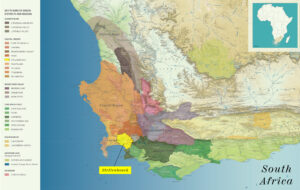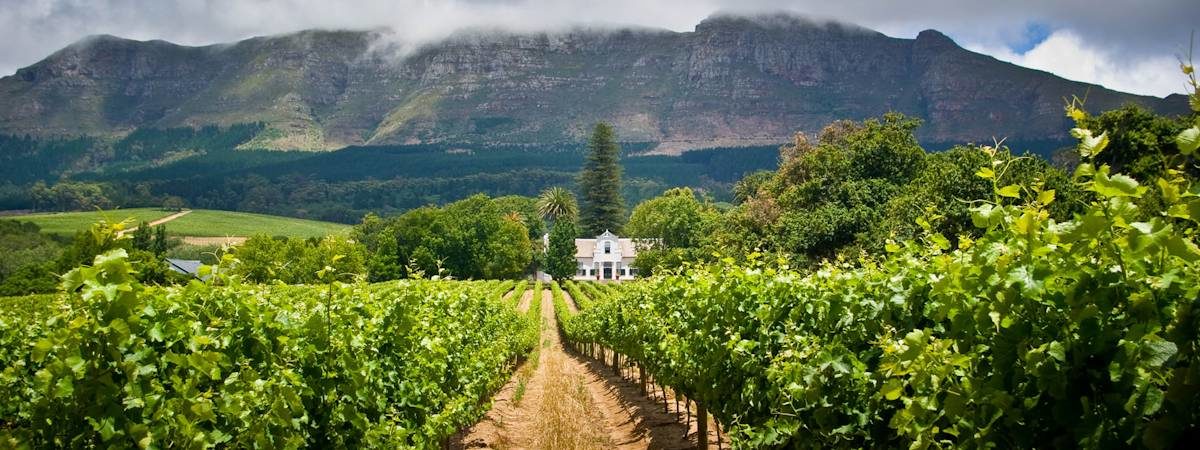Wine Regions of South Africa
Intro To Wine Regions
The Cape winelands span from the rugged mountains and varied slopes of the coastal region to the open and wild plains of the Klein Karoo, where viticulture primarily takes place in the riverine valleys. Each region has its own unique characteristics and microclimates, allowing winemakers to craft an array of styles, from elegant and cool-climate whites to bold and robust reds.
The vineyards of South Africa are predominantly located in the Western Cape, near the coast, where the icy Atlantic Ocean helps moderate temperatures. On the coastal side, where fynbos and renosterveld (‘rhinoceros field’, derived from the historical presence of rhinoceros in these grassy plains) thrive, the annual rainfall measures up to 39 inches. As one travels over the mountains into the wilderness, the rainfall dramatically decreases, and the vegetation is dominated by hardy succulents, cycads, and aloes.
There are nearly 225,000 acres of vineyards under cultivation today, covering an area of about 500 miles in length. Under the Wine of Origin Scheme, the production zones in the Cape winelands are divided into officially demarcated geographical units, regions, districts, and wards.

South African Wine of Origin Scheme Overview:
The Wine of Origin (WO) Scheme is a comprehensive framework that ensures the authenticity, traceability, and quality of wines produced in South Africa. It also plays a crucial role in preserving and enhancing the reputation of South African wines, both domestically and internationally.
The Wine and Spirit Board, a regulatory body established by the South African government, oversees the Wine of Origin Scheme in South Africa. The board is responsible for implementing and enforcing the regulations related to the production, classification, and labeling of wines within the country. It ensures that wines carrying the Wine of Origin designation meet the prescribed standards and are accurately labeled according to their specific geographical origin. The Wine and Spirit Board plays a vital role in maintaining the integrity and authenticity of South African wines in both domestic and international markets.
With the help of another regulatory body, SAWIS, every bottle produced in South Africa must be labeled with a grape tracing tag (BLOG LINK SAWIS HERE), showing full transparency of the grape(s) origin. It’s a revolutionary system that no other wine producing region in the world offers (yet).
By categorizing wines according to their specific geographical origin, including regions, subregions, wards, and estates, the scheme provides valuable information to consumers. This system enables wine enthusiasts to explore and appreciate the diverse range of wines produced in South Africa, while instilling confidence in the origin and integrity of the wines.
Geographical Unit
Geographical Units are the largest area within the WO system. They include regions, districts, and wards, providing a hierarchical framework for organizing and classifying South African wines. For example, within the Western Cape geographical unit – by far the most important in the country – there are five sizable regions: Breede River Valley, Cape South Coast, Coastal Region, Klein Karoo, and Olifants River. Additionally, there are five other geographical units: Eastern Cape, Free State, KwaZulu-Natal, Limpopo, and Northern Cape.
Region
A region refers to a larger geographical area that encompasses multiple subregions and reflects distinct grape-growing conditions and wine styles. Regions serve as a fundamental classification for wines, providing consumers with an understanding of the broader origin and characteristics of the wines they purchase and enjoy. The most commonly seen Region is ‘Coastal Region’. Stellenbosch, Franschhoek and Paarl fall within the Coastal Region.
District
Districts are broader areas that encompass several wards. The well-known wine producing areas like Stellenbosch, Franschhoek, Paarl, Swartland, Walker Bay and Elgin are districts.
Ward
Wards are the smallest viticultural areas. Wards are small areas within districts that even go as far as defining specific vineyard sites. Bot River is a ward within the Walker Bay district.






